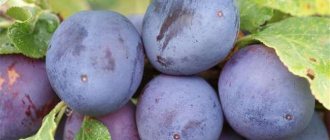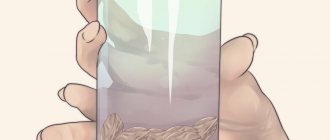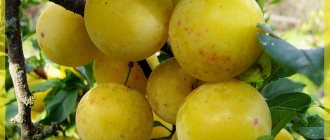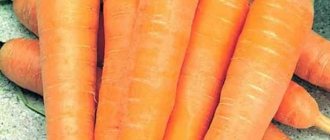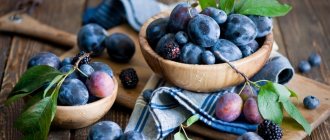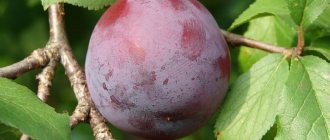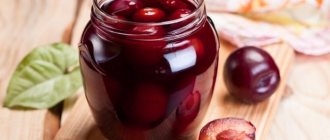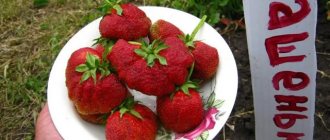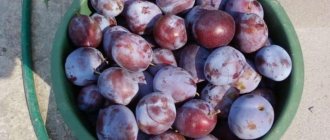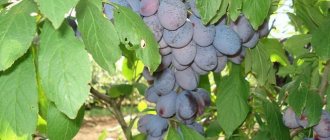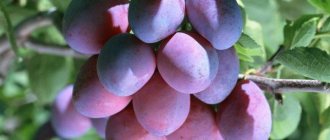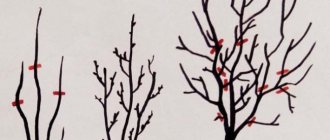There is hardly a gardener who does not grow plums. This popular crop is liked by many for the taste and versatility of its fruits, as well as its ease of care. Despite the fact that plum is considered a heat-loving plant, breeders have developed many varieties suitable for the Urals and Siberia. These varieties can withstand severe Siberian frosts and delight their owners with a high-quality harvest. One of these varieties is “Altai Jubilee”.
The variety was developed by breeders in the Altai climatic zone from the Manchurian Prune and Immunnaya varieties. Considered one of the most valuable Siberian varieties, it was included in the State Register in 1974. Recommended for use in the Siberian and Ural regions, in Northern Kazakhstan.
Altai Jubilee plum: description of the variety with photos
The plum tree has a crown of medium density and round shape. The branches are brown-gray. The shoots are of considerable thickness and straight. The leaves are large in size, 12.5x7 cm, dull light green in color, with a reddish tip. The petiole has a dark anthocyanin color and is of medium length. The bud produces 2-3 flowers, which open before the leaves appear. The buds are white.
The fruits of the Altai Jubilee plum weigh 14-16 grams and have an angular-round shape. The suture-groove is clearly pronounced. The color of the fruit is yellow-orange with a scarlet blush and has a waxy coating. The skin is soft and not bitter. The pulp of the fruit is juicy, tasty, yellow-orange in color.
Altai Jubilee plum is a mid-early variety. The fruits ripen by mid-August or a little later. The tree bears fruit for 3-4 years.
The variety is universal.
Crown and leaves
The tree is distinguished by high and medium growth vigor, reaching from 3 to 5 meters in height. Rounded reverse pyramidal raised crown of medium density. There are many large lenticels on the straight and thick shoots; the bark is brown-red. Skeletal branches of a grayish-brown hue grow at an acute angle from the trunk. A distinctive feature is the large subrenal bases.
The light green leaves without gloss have the shape of a wide oval, quite large - 12.5 cm long, 7 cm wide. Leaf buds are conical. The leaf blade is wedge-shaped with a sharp curved tip, folded in the shape of a boat with a gathering in the area of the central vein. New leaves with a red tint are on the upper part of the shoots and are slightly drooping.
Advantages and disadvantages of the variety
Having examined the description of the “Altai Jubilee” plum variety with a photo, you should dwell on the pros and cons of this plant.
The advantages of the variety are:
- excellent taste properties of the fruit;
- abundant fertility;
- strong winter hardiness of trees;
- resistance to clasterosporium blight.
The disadvantages can be considered:
- instability to weathering;
- low transportability of plums;
- insufficient drought resistance;
- self-sterility;
- damage by seed eater.
These are the main characteristics of the Altai Jubilee plum.
Variety Red ball
It was bred by crossing the Burbank and Ussuriyskaya Red varieties probably 30 years ago. Large round fruits weighing from 30 to 45 grams. The thick skin is red in color with a bluish, waxy coating. The pulp is pale yellow, sweet, very juicy, slightly loose in structure.
The tree is relatively low, no more than 2.5 m in height, the crown is round-hanging with a small number of branches. The fruiting period begins a year or two after planting, it all depends on the growing conditions. The Red Ball blooms in early spring, and the fruits ripen by the end of July. It is better to start harvesting in the first half or mid-August, and since this variety bears fruit abundantly, on average you can collect a very good harvest from each tree.
Advantages: large size of the fruit, dense skin (allows it to withstand long-term transportation well), winter hardiness of the buds and seedlings as a whole, resistance to klyasterosporiosis, early and abundant fruiting
Disadvantages: over time, the fruits become smaller, their ripening period may increase, the basal neck sometimes becomes warm, the fruit has a specific taste.
Selection of seedlings
Future productivity is largely determined by the quality of planting material. Choosing good seedlings is not so easy.
It is best to purchase seedlings in the spring. Experts give several recommendations in this direction:
- First of all, you should evaluate the appearance of the seedling. It should not show signs of disease, drying out or other damage. Each tree should have a tag with information about the variety, manufacturer and other useful data. The roots of a healthy seedling have a light shade without spots or diseases.
- The height of the seedling can tell you whether it was properly cared for when growing. For annual seedlings grown from seed, the height is 1.5 m. If it has not reached this value, the tree may not have been sufficiently cared for. If the height is much higher, the trees may have been grown using the wrong technology.
- The taste of fruits depends on agricultural technology and climatic conditions. Therefore, experts recommend growing varieties bred specifically for a specific area.
- For quick establishment, you need to take 1-2 year old seedlings. Older plants are more difficult to tolerate transplant stress.
- When purchasing seedlings, you should familiarize yourself in advance with possible diseases of the variety and methods for overcoming them.
These are the main recommendations when purchasing plum tree planting material.
Growing rules
You need to carefully select planting material, since the quality of the future harvest depends on it. The main rules for choosing seedlings include the following:
- there should be no signs of disease or damage on the surface;
- a tag must be presented on the trunk, which indicates not only the variety of seedling, but also the timing of its fruiting;
- the roots should be light brown in color;
- the height of the seedling must be at least 150 cm;
- The age of planting material is up to 2 years; adult bushes take root less well in unfamiliar soil.
It is better to plant planting material in early spring.
The procedure for planting in the soil
From the end of autumn, the planting hole is prepared. Its dimensions should be 50x70 cm. Humus, compost and mineral fertilizers (superphosphate and ammonium nitrate) are poured inside. Provided that the acid-base balance of the soil exceeds 4%, add a limestone solution (2 kg of lime per 10 liters of water). This will help reduce the acidity of the soil and improve the quality of plant survival. If the soil is heavy, then additional sand is added.
Planting should be carried out in elevated areas so that groundwater does not disturb the development of the bush. If this is not possible, then a drainage system made of crushed stone or wood shavings is installed at the bottom of the hole. A seedling is placed in the hole and the roots are tightly covered with soil. The root collar should be at least 5 cm above the ground. Due to the high growth of the plant, the seedling is tied to a support made of metal or wood. Its optimal height is 2 m.
Yubileiny yellow plum trees need to be planted according to a certain pattern. The seedlings are placed at a distance of 4 m from each other. The inter-row space should be 2 m.
Landing
With proper planting and care, the Altai Jubilee plum will delight gardeners with good yields and no problems during cultivation.
Plum trees are planted at a distance of 2-3 meters from other crops. Places with little snow should be level.
The best season for planting plums in Siberia is considered to be spring or early autumn. They make holes 50 cm deep and 60-100 cm wide. Organic matter, superphosphate, potassium, lime are placed down and mixed with soil. Heavy soil needs to be diluted with sand.
The seedling must be shortened by 30-50%. After planting, the plant is well watered and mulched with an organic mixture.
In areas located in the lowlands, plums are planted on hills up to 50 cm high and up to 200 cm wide. Fertilizers from organic matter, saltpeter, superphosphate, potassium salt are applied in advance, dug up, and a hill is formed from the ground, mixing gravel with sand. A depression is made in the center of the hill, more fertile soil is placed in the middle, and sand and gravel are placed along the edges.
In snowy areas, they can be planted in boxes without a bottom. To do this, you need to prepare 1x1 meter boxes. The material may be different:
- tree;
- slate;
- iron.
The box is filled with soil filled with fertilizers, and a plum is planted.
Plum - general information:
- This fruit tree belongs to the Rosaceae family and includes more than 200 varieties.
- It is believed that this culture comes from the warm climate zone of the Adriatic, Caucasus, and Balkans.
- Scientists agreed that this culture appeared by crossing cherry plum and thorn.
- The maximum height of this tree is 15 meters.
- On average, this culture can live up to 20-25 years.
- Early ripening species can bear fruit already in the 3rd year after planting, late ripening species - only in the 6th or 7th year.
- The plum has a tap root; it is mainly located at a depth of 20 to 40 cm.
- Plum flowers are small and white in color. Diameter - up to 2 cm. The leaves are oval in shape, and have a width of up to 5 cm, length - up to 10.
What are the benefits of plum fruits?
Plum fruits are very healthy, they contain: boron, copper, phosphorus, manganese, zinc, malic acid, etc. Substances are contained not only in the pulp, but also in the peel and seeds.
Care
In the spring, the Altai Jubilee plum needs sanitary pruning. Old branches that do not grow, as well as weak and diseased ones, are removed.
If a tree bears fruit annually, it is enough to prune it once every 2-3 years. Perennial branches are cut out. Do not touch annual branches. Garden varnish is applied to the wounds.
Branches that are frozen are cut back to healthy wood.
Pruned trees are fed and watered.
After planting, the plum tree is not fertilized for 3-4 years. After the start of fruiting, they are fed with a mixture of 7 kg of organic matter and 100 g of ash. Every two to three years they feed with fluff lime.
Watering after the 2nd year of life should be limited. Excess moisture promotes vigorous growth, aphids, low yields and increased winter damping off.
Young plants need heavy watering. Fruiting plums are watered 1-2 times, including before loading the fruit. After collecting the plums, watering is stopped.
Advantages
- Low temperature resistance;
- high level of fruiting;
- excellent tasting qualities;
- beautiful appearance of the fruit;
- versatility of crop use.
The fruits are good for fresh consumption, and they also make excellent compotes and jams.
and disadvantages of the variety
- Low drought resistance;
- the need for planting on a site with this variety of pollinating plums;
- weak immunity;
- non-transportability.
Altai Jubilee is one of the few varieties that can be safely planted not only in spring, but also in autumn.
The main thing when planting plums is to choose a good place, protected from cold winds and open to sunlight.
When choosing a location, you need to pay attention to sufficient illumination of the site, absence of drafts, and sufficient depth of groundwater. The best place for planting is the south or west of the garden. The optimal type of soil is loam.
The main requirement for a seedling is a healthy root system and a height of 1.3-1.5 meters. The best ones are one-year-olds or two-year-olds, but the latter take root a little worse. Planting material should be purchased from a nursery.
The algorithm for landing will be as follows:
- dig a planting hole with a depth of 50–70 cm;
Scheme of planting plum seedlings.
- mix the extracted soil with lime, organic matter, potassium and superphosphate;
- place half the soil back in a small mound;
- after 2 weeks, plant a seedling with a well-developed root system in the hole;
The seedling is placed on a mound, measuring the planting depth along the root collar.
- sprinkle with the remaining soil without deepening the root collar;
- compact the soil, water the seedling, and the soil around mulch.
It is best to mulch the seedling with humus, fallen leaves or compost.
The best neighbors will be pollinating plums of a different variety ( Chemalskaya, Katunskaya ) or apple trees . It is allowed to plant black currant bushes or flowers nearby. But you shouldn’t plant pears, cherries, peaches or cherries nearby.
High-quality watering is very important for the full development of the tree.
As a rule, the first procedure is carried out immediately after planting (2-3 buckets), the second before flowering, the third after it ends, and the last during the main fruiting period.
In dry autumn, moisture-charging irrigation is additionally carried out.
Trimming
Sanitary pruning is carried out 1–2 times a year . Diseased and damaged leaves are removed. Formative - in the second year of life . It allows you to give the desired shape to the crown and partially thin out the foliage so that future fruits receive enough sunlight.
Top dressing
In the first 3 years after planting, fertilizing is not carried out.
Then, after the first harvest, you can add wood ash and organic matter, use nitrogen-containing complexes in the spring, and fluoridated mixtures in the fall.
Preparing for winter
In the photo, the plum trunk is wrapped in soft fiberglass - it helps against rodents and frost damage.
In late autumn, moisture-recharging watering is carried out, the last fertilizing with fluorine is applied, and a cover for the tree trunk circle is formed. For this, spruce spruce branches or agrofibre are used. Some gardeners also tie the base of the trunk to protect it from rodents.
Diseases
The Altai Jubilee plum, like other varieties, is susceptible to some diseases. These include:
- Gum treatment. Trees exposed to severe frosts, as well as heavily fertilized plants, are affected. The affected areas are cleaned with a knife and treated with copper sulfate. To prevent disease, do not get too carried away with fertilizers.
- Dwarfism. Characterized by the appearance of small leaves, decreased growth and development of the tree. As a result, the plum may die. To combat dwarfism, the tree is completely uprooted. To avoid disease, you should keep your tools clean when working in the garden.
- Clusterosporiasis. Signs of the disease are small spots on the leaves, after which holes appear. Bordeaux mixture is used to treat and prevent the disease. It is also important to remove and burn all old shoots in a timely manner, as well as dig up the soil in the tree trunk circles. “Altai Jubilee” is not often affected by this disease, but the gardener still needs to know about it.
- Rust. Characterized by the appearance of yellow spots on the leaves. Bordeaux mixture and other fungicides are used for control. Prevention consists of digging up the tree trunk circle and burning excess foliage in the area.
- Chlorosis. The disease appears as green veins on yellow leaves. To avoid chlorosis, you need to plant or replant the plum tree correctly. The disease appears on trees growing in calcareous soils. Therefore, when planting, reduce the amount of lime. The drugs Antichlorosin and Chelate also help against chlorosis.
How to care for plums in Siberia
Caring for a plum tree in Siberia requires following certain rules that will help you get a rich harvest every year. The requirements are multifaceted, therefore they are combined into several groups.
Preventing ground freezing
Most types of plums are winter-hardy, but they are not immune to damping off. This happens due to large volumes of snow and lack of frost. There are three ways to protect a tree:
- When planting, place small stones in the hole.
- In case of heavy snowfalls, immediately compact the layer of snow around the tree.
- Installation of barrels around the trunk, several times higher than the expected height of snow. The volume of one barrel must be more than 200 liters.
Using available materials (for example, slate) you can create an impermeable layer. The method is called “dry wintering of the trunk.”
Watering and fertilizing
Young seedlings are watered once a week; trees over 2 years old should be watered no more than 3 times a season. You need enough water to wet the soil to a depth of 30 cm. As a rule, 3-4 buckets are enough for this.
Note! Excess moisture will lead to pests. Therefore, you need to familiarize yourself in advance with the features of caring for the selected variety.
As a rule, the first watering is carried out in mid-May, the second - as soon as the plant finishes blooming, the third - during the ripening period, the fourth - in mid-autumn.
If you plant the seedling correctly, adding a sufficient amount of fertilizer to the hole, you need to fertilize it twice a year:
- In autumn - with preparations high in phosphorus and potassium.
- In spring - substances containing magnesium and nitrogen.
You can use organic fertilizers: ash, turf, manure, humus.
Crown formation
Once every 3 years, dried branches from trees that have already begun to bear fruit are pruned. In the spring, sanitary pruning of branches (no more than 30% of the crown) that have suffered from winter frosts is carried out.
To form a beautiful and neat crown, the side shoots are removed, leaving only the largest shoot. In addition, root shoots also hinder the development of the plant; they need to be removed in the spring.
Diseases and pests
The main pests of plums are codling moths, aphids and sawflies. To prevent their attack:
- spraying with special preparations (sold in a specialized store);
- treating the trunk with slaked lime;
- watering and spraying with chamomile decoction.
Clusterosporiosis often affects plums. The first signs are brown spots on the leaves. The disease can be controlled using fungicides and insecticides.
Note! To get rid of the bulk of harmful insects, a birdhouse on a tree will help. But be sure to feed the birds regularly so that they do not spoil the fruits.
Post-harvest care
After harvesting, the plum will need to be given a little more attention. At the beginning of autumn, the soil is fertilized. To do this, you can use the preparations Healthy Garden or Extrasol. They are intended for fertilizing plants in the tree trunk circle by watering. You will also need to update the mulch by adding some humus and fresh hay.
Pests
The two main pests of plums are aphids and seed beetles.
Aphids feed on leaf juices. To notice it, you need to look at the leaves from below more often. At the initial stages of the appearance of aphids, you can remove them with an infusion of shag and tobacco. 400 grams of the mixture are poured with 10 liters of water, left for two days, then soap is added and the leaves are sprayed three times.
Maslovsky's seedeater is an insect that looks like an ant with wings. The seed eater lays eggs in plum fruits. You can find a worm in a plum pit. Solutions of “Lepidocide” and “Aktellika” help against the seed eater.
What problems can you encounter when growing
The main problem is the close planting of seedlings. Also, many gardeners ignore fertilizing and watering. It seems to them that since the plum bears fruit, then everything is fine. But if you do not take care of the plant, very soon the yield will begin to decline. Another problem is improper fit. It is not advisable to plant plum trees only where there is free space.
It is important to choose a place where the plant will feel comfortable. You can't plant plums in the shade
Plum, like all stone fruits, tends to grow. Many gardeners prefer not to cut down young growth. And it is necessary to do this. After all, it takes all the nutrients, and the parent plant has nothing left.
Pollinators
The Altai Jubilee plum is a self-sterile variety belonging to the group of plums that bloom early. For this reason, the tree is not pollinated by varieties for central Russia and requires varieties of its own group as pollinators. These include:
- "Ksenia";
- "Katunskaya";
- “Memory of Putov”;
- "Chemal";
- "Uzyuk".
All these plums are distinguished by early flowering and fruiting.
It’s good if representatives of other plum varieties grow in the neighboring area. This will be enough for the pollination process. But if your neighbors do not have plum trees, you should plant pollinating varieties of the “Altai Jubilee” plum on your plot. Only in this case can you expect a good harvest.
Variety Memory Timiryazev
This variety is even older than the previous two. Its breeders bred it in the mid-twentieth century by crossing Skorospelka red and Victoria. This is the most common variety of self-fertile plum. The size of the average fruit is on average 3 cm in height and weighs no more than 25 g. The shape is ovoid, the color is predominantly yellow with a red side. The pulp is dense, fine-grained and medium juicy. The taste of the fruit is sour.
The tree is medium-sized with a round, bush-like, non-thickened crown. Having planted seedlings of this variety, the first harvest will be harvested only after 3-4 years. The Timiryazev Memory plum is a late plum, since it blooms towards the end of spring, and the fruits ripen in late summer and early autumn. The amount of fruit that can be collected from one tree is usually not very large.
Positive qualities of this variety: fruit quality, ability to quickly recover, resistance to fruit rot and clasterosporiosis.
Negative qualities: low cold resistance, very susceptible to mites, does not tolerate drought well.
Planting and caring for plum trees in Siberia
Plum is an excellent option for a Siberian garden. With careful care and following the basic rules, the trees give gardeners beautiful juicy and tasty fruits. Plums are delicious fresh, but are also great for jams, preserves and baked goods.
We have been living in Siberia for a long time, but only recently became the owners of a small summer cottage. Thinking about what to plant it with, my gaze fell on my neighbors’ plot - beautiful trees with red and yellow plums grew there. Therefore, we also decided to try to plant several varieties of plums.
This article describes different varieties of plums for Siberia, as well as recommendations for caring for them.
Greengage
Next is the Renclod plum, a description of the varieties. According to legend, the name was invented by King Louis the Twelfth in honor of his wife Claudine (Claude), who was distinguished by her cheerful disposition (Rhine). This was in the 16th century. There are many varieties of this variety.
Renklod Green
It was for him that the French monarch came up with the name. And so this variety remained the king of the green crops due to the quality of its fruits.
The tree is tall and fast growing. At the age of five it produces its first harvest; from a ten-year-old plant you can get 50 kilograms of plums. They are not attractive to look at, but they are tasty and well suited for canning.
The variety is self-sterile. It is good to plant Hungarian (Azhanskaya, Italianskaya, Domashnaya) nearby; these varieties and Renklod Zeleny pollinate each other.
Renclod Altana
Bred in the Czech Republic. We are zoned in the North Caucasus and Lower Volga regions. The vigorous tree has an oval crown. Blooms in April, bears fruit in August. It bears fruit in the fifth year of life. Tolerance to cold and drought is average.
The plant is self-sterile. Other varieties must be planted nearby for pollination. The harvest is high, but irregular. The fruits are tasty and suitable for eating raw and for cooking. Weighs 40 grams. The skin is thin and easy to remove.
Renklod Sovetsky
Obtained at the Rososhansk experimental station. The trees are low-growing with large, up to 80 grams, fruits with juicy, dense, sour flesh. Plums turn sour in dishes, so they are used fresh. The plant easily tolerates frost and is resistant to disease.
Renklod Early
It bears fruit in July.
Renklod Kolkhozny
Bred by Michurin from Ternosliv and Renklod Zeleny. Distributed in the Central Black Earth Region. The variety has excellent frost resistance and high yield. The fruits appear five years after planting. An eleven-year-old tree produces up to 40 kilograms of plums.
Renklod Ternovy
Also a Michurin variety. Derived from crossing Renclad Green with blackthorn. The variety is self-fertile. Refers to tableware type. The fruits are used to make jams, marmalades, and so on.
Other Renklody
There is also Renclod Karbysheva, Renclod Yellow, Renclod Michurinsky, Renclod Reforma, Renclod Bave, Renclod Harvest, Renclod Kolkhozny and others.
Under this name, different varieties of the same species are united - domestic plum. Western Europe is considered to be the homeland of Renclod plums. These are trees with a height of 5 to 7 m. The berries are egg-shaped. Their color, depending on the variety, can range from yellow-green to purple. The peel is matte.
This group received particular value for its taste. The fruit inside is soft, juicy and sweet. Productivity directly depends on weather conditions. They can bear fruit even once every few years.
- Green
- Enikeeva
- Soviet
- Blue
- Prizedentsky
- Michurinsky
- Karbysheva
- Kuibyshevsky
- Leah
- Tatar
- Ulena
Read more: Bull insemination producer feeding maintenance
Let's look at some of them in more detail.
Kharitonovskaya
- Renklod Green
- Donetsk early
- Renclod Altana
- Hungarian Donetsk
